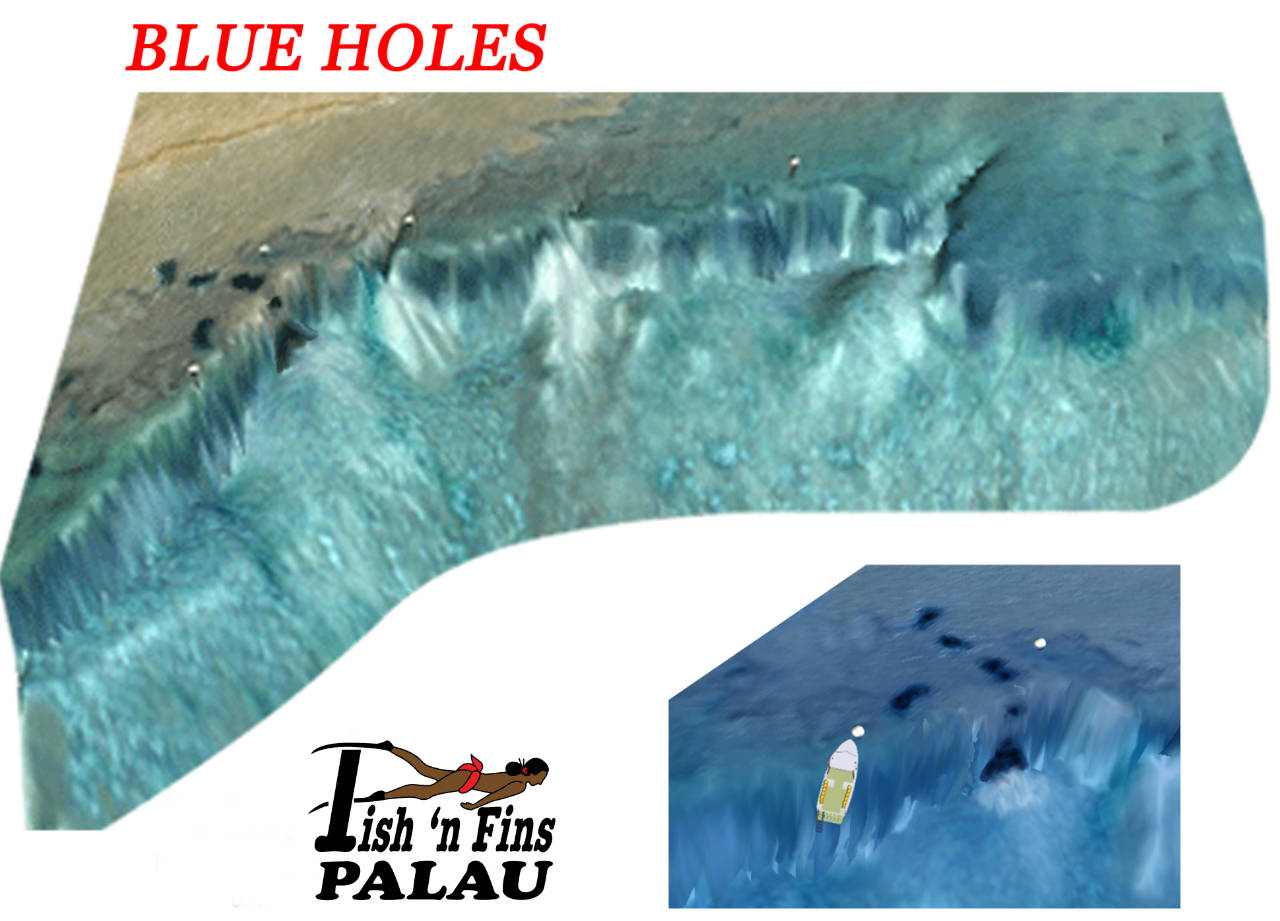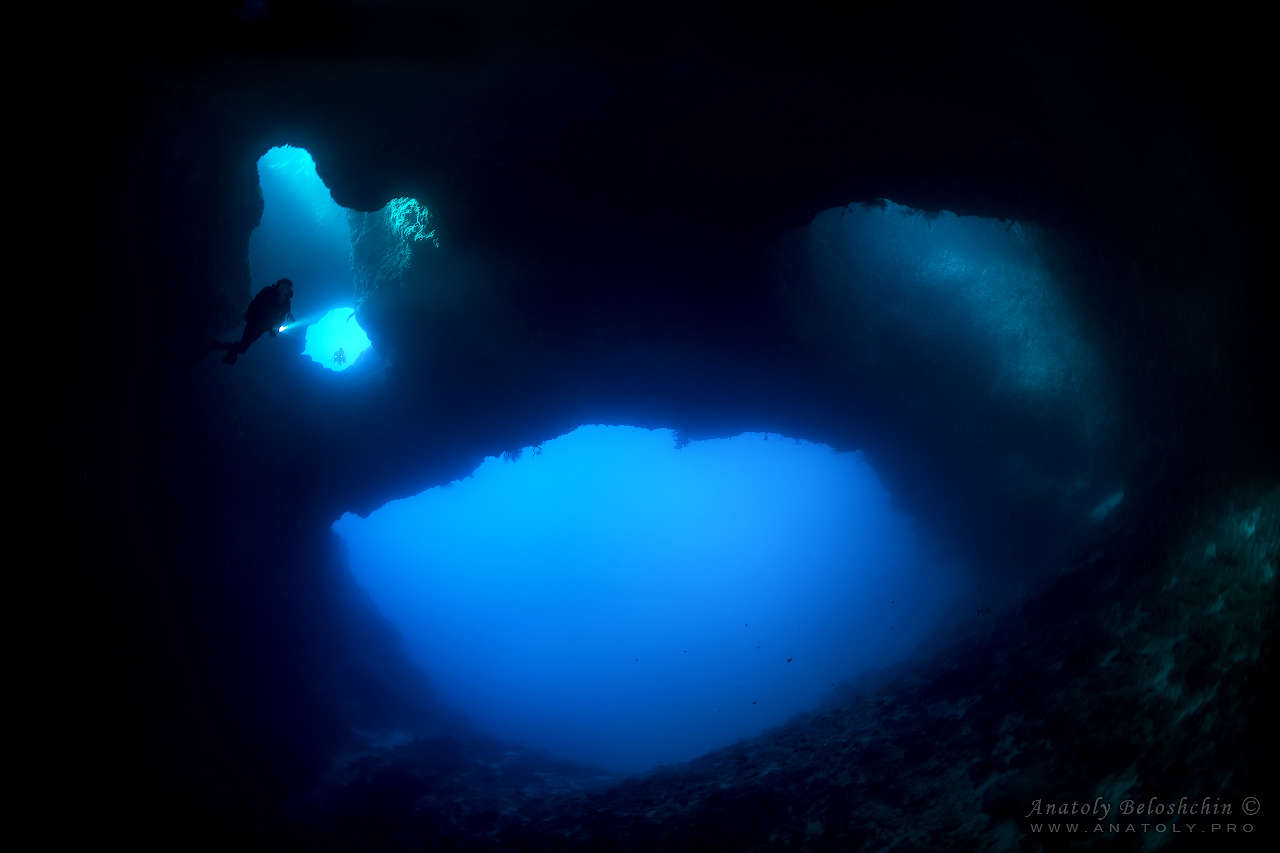Blue Holes Palau
Mystical diving in Palau - Blue Holes
The Blue Holes are one of the popular ways to start your dive to Blue Corner. The holes form the top of a very large cavern. On the face of the reef there are two (2) exits. One is a small 15-foot (5 meter) diameter window at 45 feet (15 meters). The other is a large opening starting at 85 feet (27 meters). The bottom of the cavern is at 120 feet (40 meters). In the north end of the cavern, at 85 feet (27 meters), is a narrow entrance that leads to another cave.
This cave is appropriately named The Temple of Doom. Several people have perished in this cave, it not for inexperienced divers. Only divers with a Cave Diver rating and special gear should enter this area. Please stay out!!!
Important notice - Blue holes are a popular dive site. Many dive boats are usually circling around the site waiting for divers. On ascent, use a Safety Sausage and keep your eyes and ears open for boats.
The current that runs along the west coast of the Palau Islands hits the reef wall at Blue Corner and flows up and over the plateau bringing with an abundance of clean water, plankton and algae. This phenomenon occasionally creates very strong currents and down drafts. The currents change with the tides and reverse direction approximately every 6 hours. As a rule of thumb the incoming tide will flow from south to north and the outgoing tide from north to south. The current at Blue Corner and Blue Holes are strongest and hardest to predict during the half- moon. When swimming from Blue Holes to Blue Corner you may have to swim against the current for about 150 feet (50 meters). When you pass the second buoy, the current will reverse and carry you to the corner. The ambient light coming into the cavern from the large opening appears dark blue; this is an excellent backdrop for award-winning photos.
Distance from Koror - 30 miles (48 km) 50-70 minutes by a speedboat.
Level of Diving Experience - Novice, intermediate.
Visibility - 60-150 feet (20-50 m).
Location
Northwest of Ngemelis Island and north of Blue Corner.
Reef Formation
A vertical wall runs from north to south and merges with Ngemelis wall at Blue Corner. Four holes on top the shallow reef 3-6 feet (1-2 m) deep, about 1000 feet (305 m) north of Blue Corner marks the ceiling of a very large cavern. There is a huge opening stretching from 85-140 feet (26-42 m). A window, 15 feet (5 m) in diameter at 55 feet (17 m) is an alternative way to swim out. At 85 feet (26 m) on the north part of the site, there is a narrow entrance at 80 feet (24 m) that leads to an even larger cave called “The Temple of Doom”. Special preparation and gear is needed in order to penetrate this cave. The wall outside the cavern is vertical and ends at Blue Corner.
Marine Life
Inside of the cavern you will find many soft corals and Tubastraea decorating the walls, along with many species of nudibranchs and shells that can be found on the sandy bottom. Schools of fish patrol the large opening (with dark blue ambient light as a background). On the way out, the wall is vertical and offers just about any type of coral and fish you can imagine! The 7-10 minutes swim to Blue Corner is rewarding.
Diving
Probably the second most popular site in Palau, the dive at the Blue Holes usually starts with swimming over the shallow reef and descending through one of the four holes on top of the reef. Occasionally if the tide is very low or the swell is high, the dive commences down along the wall and into the cavern. Swimming through the hole, you will discover a very big cavern. Flooded with rays of light, each hole on the ceiling is light blue and the very large opening to the west is dark blue. Spend some time in the cave and enjoy the sight of it before swimming out toward Blue Corner. Do not attempt to enter Temple of Doom unless you are prepared for cave diving and accompanied by a guide who knows the place! On your way out from Blue Holes, keep the wall to your left and kick toward Blue Corner, you will pass through beautiful canyons and crevices. The wall is colorful and rich with marine life. At the corner, hook yourself and watch the sharks playing in the current.
Fascinating Facts
Recognizable from the air, early divers in the late 1950’s considered Blue Holes as one of the first dive sites in Palau.



